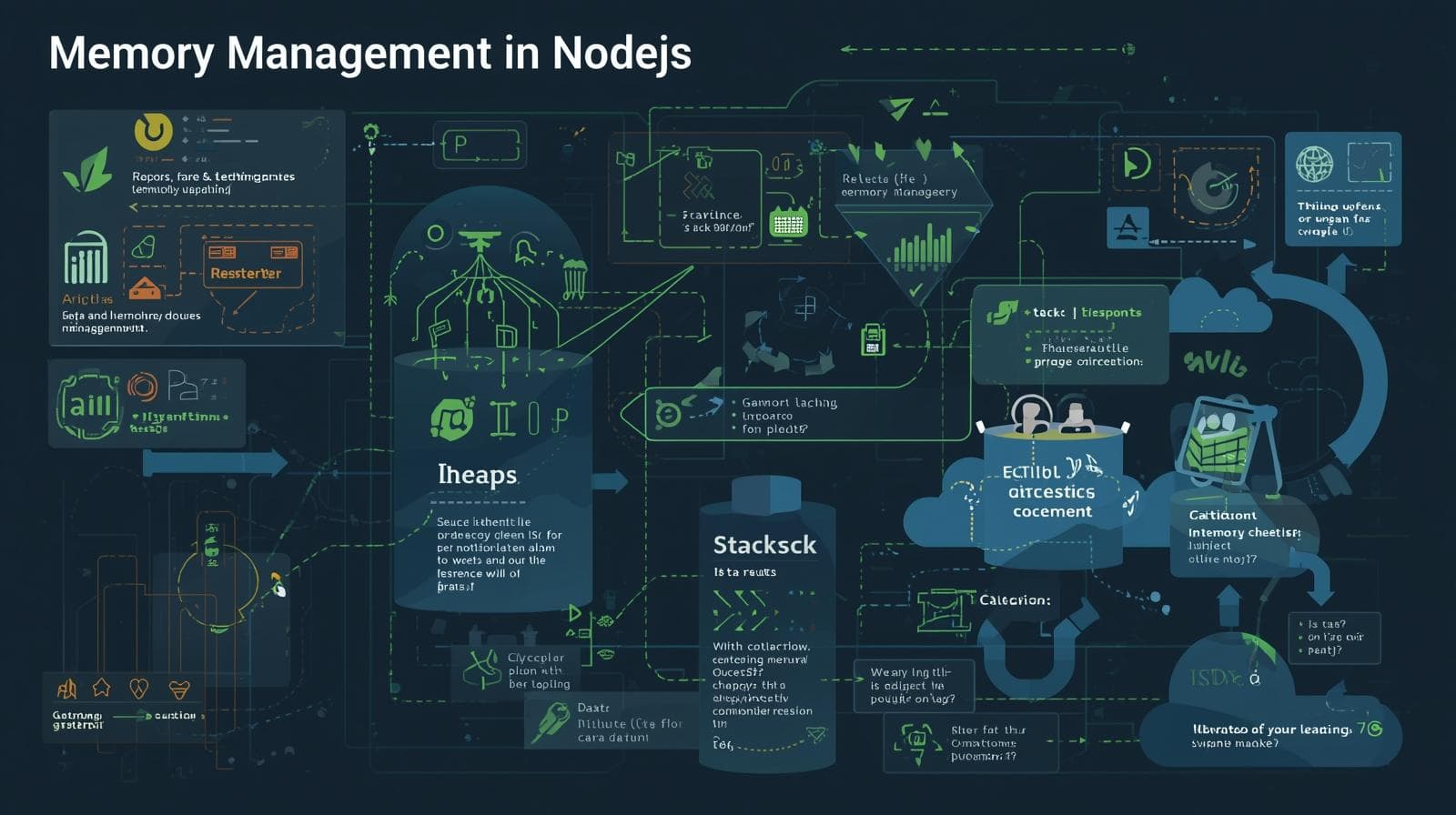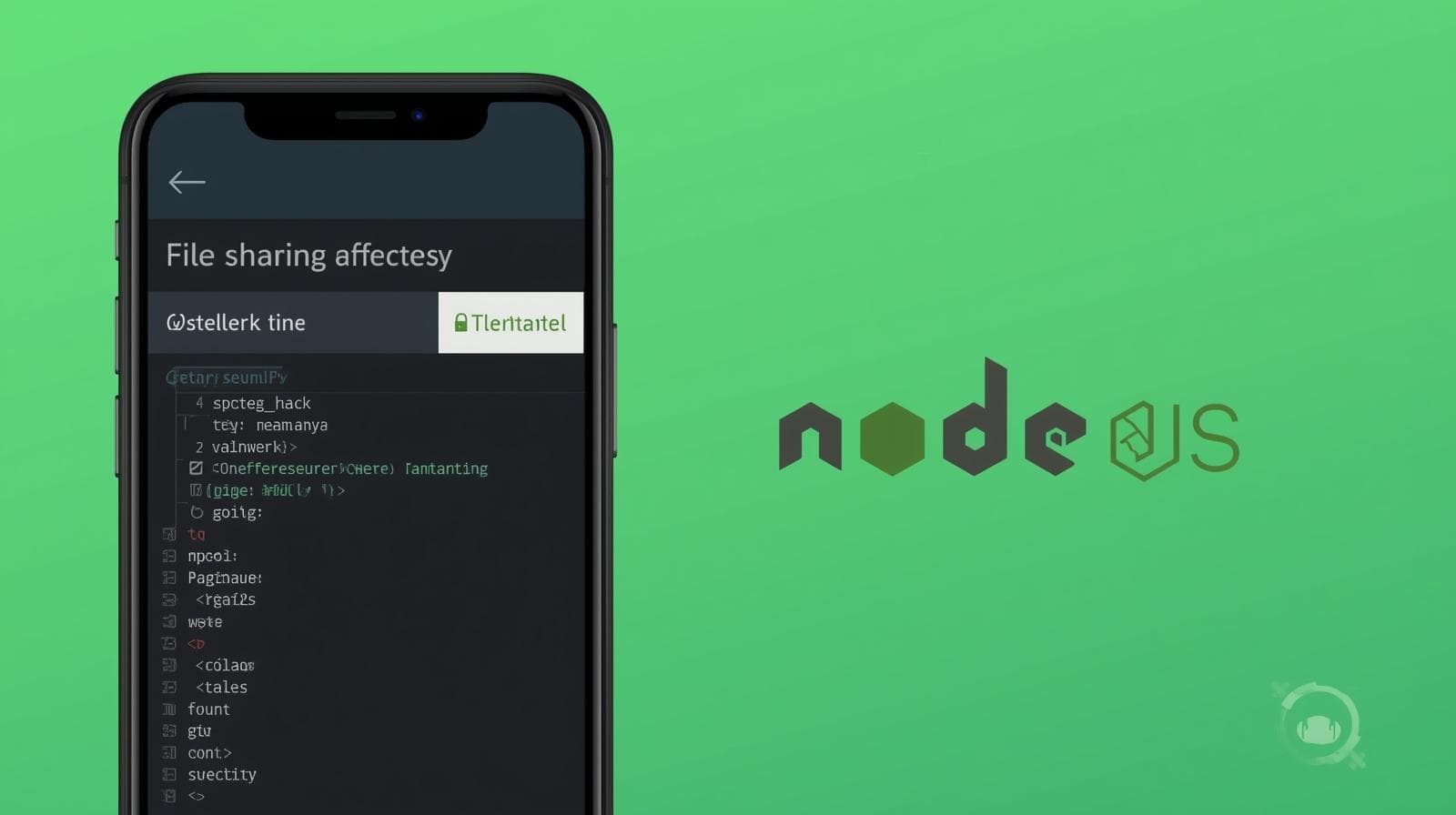Build a URL Shortener with Node.js: A Step-by-Step Guide

Learn how to build a custom, feature-rich URL shortener from scratch using Node.js, Express, and MongoDB. This in-depth guide covers hashing, redirects, analytics, and best practices

Build a URL Shortener with Node.js: A Step-by-Step Guide
Build a URL Shortener with Node.js: Your Ultimate Step-by-Step Guide
We've all seen them—those cryptic, shortened URLs from services like Bitly and TinyURL that tidy up long, messy links. They're essential for social media, marketing campaigns, and just about any situation where you need a clean, manageable link. But have you ever wondered how they work? What magic happens behind the scenes when you click that bit.ly/abc123 link and land on a page miles away on the internet?
The truth is, it's not magic. It's a brilliant and relatively straightforward piece of web engineering. And today, you're going to build one yourself.
In this comprehensive guide, we'll roll up our sleeves and build a fully functional, custom URL shortener from scratch using Node.js, Express, and MongoDB. This won't be a toy project; we'll incorporate features like custom slugs, redirects, and even a basic analytics tracker. By the end, you'll not only have a powerful tool for your own use but also a deep understanding of a fundamental web development concept.
To learn professional software development courses such as Python Programming, Full Stack Development, and MERN Stack, visit and enroll today at codercrafter.in. Let's turn your curiosity into code!
What is a URL Shortener, Really?
At its core, a URL shortener is a web service that takes a long URL and generates a significantly shorter, unique alias for it. When a user visits this short URL, the service quickly looks up the original long URL and redirects the user there.
The Basic Workflow:
Submission: You give the service a long URL (e.g.,
https://www.example.com/very-long-path/to-a-specific/article/about/nodejs?source=twitter&campaign=summer_sale).Generation: The service creates a unique, short code (e.g.,
xY7z7a).Storage: It stores the pair
(short_code, long_url)in a database.Redirection: When you visit
yourshortener.com/xY7z7a, the service finds the original URL in the database and sends an HTTP redirect command to your browser, sending you to the long destination.
It's a simple map: a small key points to a large value.
Why Build Your Own? The Real-World Use Cases
"Why not just use Bitly?" It's a fair question. Third-party services are great, but building your own unlocks several powerful advantages:
Branding: Create branded links like
mybrand.codes/new-productinstead of a genericbit.lylink. This looks more professional and builds trust.Control & Privacy: You own all the data. You're not subject to another company's terms of service, rate limits, or privacy policies. Your analytics data stays with you.
Custom Features: Need a special expiration time, password protection, or geotargeting for your links? With your own service, you can build exactly what you need.
Learning Experience: This is the most important reason for us! Building a URL shortener is a fantastic project that teaches you about REST APIs, databases, hashing, and HTTP protocols. It's a perfect portfolio piece.
What We're Building: Project Scope
Our URL shortener, which we'll call "CoderShort," will have the following features:
A simple API to submit a long URL and get a short URL back.
The ability to specify a custom "slug" (the short code) or have one generated automatically.
A redirect endpoint that takes the short code and sends the user to the original URL.
Basic click analytics to track how many times a short link has been used.
A simple front-end form to create links easily.
Tech Stack Breakdown
Node.js & Express.js: Our runtime and web framework for handling HTTP requests and building the API.
MongoDB & Mongoose: Our NoSQL database for storing the URLs and the ODM (Object Data Modeling) library to interact with it easily.
EJS: A simple templating engine to render our front-end HTML pages.
Bootstrap (CDN): For quick and clean styling without much effort.
Step 1: Setting Up the Project
First, make sure you have Node.js and MongoDB installed on your machine. You can download them from their official websites.
Let's initialize our project and install the necessary dependencies.
Open your terminal and run:
bash
# Create a new project directory and navigate into it
mkdir codershort
cd codershort
# Initialize a new Node.js project (creates package.json)
npm init -y
# Install our core dependencies
npm install express mongoose ejs
# Install nodemon as a development dependency to auto-restart our server
npm install --save-dev nodemonNow, let's modify the package.json file to add a start script for convenience.
json
// package.json
"scripts": {
"start": "node app.js",
"dev": "nodemon app.js"
},Step 2: Building the Foundation - The Server and Database
Create a new file named app.js in your project root. This will be the entry point of our application.
javascript
// app.js
const express = require('express');
const mongoose = require('mongoose');
const path = require('path');
const app = express();
const PORT = process.env.PORT || 3000;
// Connect to MongoDB
// Make sure your MongoDB service is running!
mongoose.connect('mongodb://localhost:27017/codershort', {
useNewUrlParser: true,
useUnifiedTopology: true
}).then(() => {
console.log('Connected to MongoDB successfully');
}).catch(err => {
console.error('MongoDB connection error:', err);
});
// Configure Express
app.set('view engine', 'ejs'); // Set EJS as the templating engine
app.set('views', path.join(__dirname, 'views')); // Set the views directory
app.use(express.urlencoded({ extended: true })); // Parse form data
app.use(express.json()); // Parse JSON data
app.use(express.static('public')); // Serve static files (CSS, JS) from 'public' folder
// Basic route for the homepage
app.get('/', (req, res) => {
res.render('index'); // This will render views/index.ejs
});
// Start the server
app.listen(PORT, () => {
console.log(`CoderShort server is running on http://localhost:${PORT}`);
});You can now run npm run dev and visit http://localhost:3000. You should see a blank page, but your server is running!
Step 3: Defining the Database Model
We need a schema to define what a "URL" document looks like in our database. Create a models directory and inside it, a Url.js file.
javascript
// models/Url.js
const mongoose = require('mongoose');
const urlSchema = new mongoose.Schema({
urlCode: {
type: String,
required: true,
unique: true,
trim: true
},
longUrl: {
type: String,
required: true,
trim: true
},
shortUrl: {
type: String,
required: true,
unique: true
},
clicks: {
type: Number,
default: 0
},
date: {
type: String,
default: Date.now
}
});
module.exports = mongoose.model('Url', urlSchema);This schema defines:
urlCode: The unique short code (slug) for our URL (e.g.,xY7z7a).longUrl: The original, long URL we want to shorten.shortUrl: The full short URL we'll generate (e.g.,http://localhost:3000/xY7z7a).clicks: A counter to track how many times the link has been accessed.date: The creation date of the short link.
Step 4: The Heart of the Matter - Generating the Short Code
This is the most interesting part. How do we generate a unique, short string for every URL? We have two main approaches:
Using a Hashing Function (like MD5 or SHA-256): We can hash the long URL and take the first 6-7 characters. The downside? Potential collisions (two different URLs producing the same hash prefix).
Using a Counter (like a Base-62 Encoder): We can use an auto-incrementing number in the database and convert it to a base-62 string (using
a-z,A-Z,0-9). This guarantees uniqueness and produces predictably short codes.
For simplicity and learning, we'll use a random string generator. It's not the most efficient for massive scale, but it's perfectly suitable for our project and avoids collisions effectively.
Let's create a helper function. Create a utils folder and a generateSlug.js file inside.
javascript
// utils/generateSlug.js
function generateSlug(length = 6) {
const characters = 'ABCDEFGHIJKLMNOPQRSTUVWXYZabcdefghijklmnopqrstuvwxyz0123456789';
let result = '';
for (let i = 0; i < length; i++) {
result += characters.charAt(Math.floor(Math.random() * characters.length));
}
return result;
}
module.exports = generateSlug;Step 5: Creating the API Endpoint to Shorten a URL
Now, let's create the POST endpoint that will accept a long URL and return a short one. We'll add this to our app.js.
javascript
// app.js (add this after the static file middleware)
const Url = require('./models/Url');
const generateSlug = require('./utils/generateSlug');
// API endpoint to create a short URL
app.post('/shorten', async (req, res) => {
const { longUrl, customSlug } = req.body;
// Basic validation
if (!longUrl) {
return res.status(400).json({ error: 'Long URL is required' });
}
try {
// Check if the URL already exists in the DB
let url = await Url.findOne({ longUrl });
if (url) {
return res.render('index', { shortUrl: url.shortUrl, longUrl: url.longUrl });
}
// Generate a slug (use custom if provided, else generate a random one)
let urlCode;
if (customSlug) {
// Check if custom slug is already in use
const existingUrl = await Url.findOne({ urlCode: customSlug });
if (existingUrl) {
return res.status(400).json({ error: 'Custom slug is already in use. Please try another.' });
}
urlCode = customSlug;
} else {
urlCode = generateSlug();
// Ensure the generated slug is unique (rare, but possible)
let exists = await Url.findOne({ urlCode });
while (exists) {
urlCode = generateSlug();
exists = await Url.findOne({ urlCode });
}
}
// Construct the short URL
const shortUrl = `${req.protocol}://${req.get('host')}/${urlCode}`;
// Create a new URL document
url = new Url({
urlCode,
longUrl,
shortUrl
});
// Save it to the database
await url.save();
// Send the response - we'll update the view to show this
res.render('index', { shortUrl: url.shortUrl, longUrl: url.longUrl });
} catch (err) {
console.error(err);
res.status(500).json({ error: 'Server error. Please try again.' });
}
});Step 6: The Redirection Engine
This is the part that makes the magic happen. We need to create a wildcard route that captures the short code and redirects the user to the original URL.
javascript
// app.js
// Redirect route - THIS MUST COME AFTER THE /shorten POST ROUTE
app.get('/:code', async (req, res) => {
try {
const url = await Url.findOne({ urlCode: req.params.code });
if (url) {
// Increment the click counter
url.clicks++;
await url.save();
// Redirect the user to the original URL
return res.redirect(url.longUrl);
} else {
// If the code wasn't found, render a 404 page
return res.status(404).render('404');
}
} catch (err) {
console.error(err);
res.status(500).json({ error: 'Server error during redirection.' });
}
});Important: The order of routes in Express matters. This wildcard /:code route should be placed after all your other specific GET routes (like /, /analytics, etc.), otherwise, it will catch those requests too.
Step 7: Creating the Front-End Form
Let's create a simple interface. Create a views directory and inside it, an index.ejs file.
html
<!-- views/index.ejs -->
<!DOCTYPE html>
<html lang="en">
<head>
<meta charset="UTF-8">
<meta name="viewport" content="width=device-width, initial-scale=1.0">
<title>CoderShort - Your Friendly URL Shortener</title>
<link href="https://cdn.jsdelivr.net/npm/bootstrap@5.1.3/dist/css/bootstrap.min.css" rel="stylesheet">
<style>
body { background-color: #f8f9fa; }
.hero { background: linear-gradient(135deg, #667eea 0%, #764ba2 100%); color: white; padding: 4rem 0; border-radius: 0 0 20px 20px; }
</style>
</head>
<body>
<div class="hero text-center mb-5">
<div class="container">
<h1 class="display-4 fw-bold">CoderShort</h1>
<p class="lead">Shorten your links, amplify your reach. Built with Node.js.</p>
</div>
</div>
<div class="container">
<div class="row justify-content-center">
<div class="col-md-8">
<div class="card shadow-sm">
<div class="card-body">
<form action="/shorten" method="POST">
<div class="mb-3">
<label for="longUrl" class="form-label">Paste your long URL</label>
<input type="url" class="form-control form-control-lg" id="longUrl" name="longUrl" placeholder="https://www.example.com/very/long/url" required>
</div>
<div class="mb-3">
<label for="customSlug" class="form-label">Custom Slug (Optional)</label>
<div class="input-group">
<span class="input-group-text" id="basic-addon3"><%= typeof shortUrl !== 'undefined' ? new URL(shortUrl).host : req.get('host') %>/</span>
<input type="text" class="form-control" id="customSlug" name="customSlug" aria-describedby="basic-addon3">
</div>
<div class="form-text">Leave blank for a randomly generated code.</div>
</div>
<button type="submit" class="btn btn-primary btn-lg w-100">Shorten URL</button>
</form>
<% if (typeof shortUrl !== 'undefined') { %>
<div class="alert alert-success mt-4" role="alert">
<h4 class="alert-heading">Success!</h4>
<p>Your long URL: <a href="<%= longUrl %>" target="_blank"><%= longUrl %></a></p>
<hr>
<p class="mb-0">Your short URL: <a href="<%= shortUrl %>" target="_blank" id="shortUrlOutput"><%= shortUrl %></a></p>
<button class="btn btn-outline-success btn-sm mt-2" onclick="copyToClipboard()">Copy Short URL</button>
</div>
<% } %>
</div>
</div>
<p class="text-center mt-5 text-muted">Want to build complex, real-world applications like this? <br> <strong>To learn professional software development courses such as Python Programming, Full Stack Development, and MERN Stack, visit and enroll today at <a href="https://codercrafter.in" target="_blank">codercrafter.in</a>.</strong></p>
</div>
</div>
</div>
<script>
function copyToClipboard() {
const shortUrl = document.getElementById('shortUrlOutput').href;
navigator.clipboard.writeText(shortUrl).then(() => {
alert('Short URL copied to clipboard!');
});
}
</script>
</body>
</html>Also, create a simple views/404.ejs file for our error page.
html
<!-- views/404.ejs -->
<!DOCTYPE html>
<html lang="en">
<head>
<meta charset="UTF-8">
<title>Link Not Found - CoderShort</title>
<link href="https://cdn.jsdelivr.net/npm/bootstrap@5.1.3/dist/css/bootstrap.min.css" rel="stylesheet">
</head>
<body class="bg-light">
<div class="container d-flex justify-content-center align-items-center min-vh-100">
<div class="text-center">
<h1 class="display-1 fw-bold">404</h1>
<p class="fs-3">Oops! This short link doesn't exist.</p>
<p class="lead">The link you followed may be broken or has been removed.</p>
<a href="/" class="btn btn-primary">Go Home</a>
</div>
</div>
</body>
</html>Step 8: Let's Test It!
Ensure MongoDB is running on your machine.
Run
npm run devin your terminal.Open
http://localhost:3000.Paste a long URL, hit "Shorten URL," and see the magic! Click on the generated short link, and it should redirect you to the original site. Check your terminal and MongoDB database (
db.urls.find()) to see the click count increment.
Best Practices for a Production-Ready Shortener
Our basic shortener works, but to make it robust and scalable, consider these best practices:
Input Validation & Sanitization: We did basic validation. Use a library like
Joiorvalidator.jsto rigorously validate and sanitize URLs to prevent malicious input.Rate Limiting: Use a middleware like
express-rate-limitto prevent abuse from a single IP address.HTTPS: Always use HTTPS in production to secure data in transit.
Database Indexing: Create an index on the
urlCodefield in MongoDB for lightning-fast lookups. (db.urls.createIndex({ "urlCode": 1 })).Handle Duplicates Gracefully: We already check for duplicates, which is crucial.
Link Expiration: Add a
expiresAtfield to your schema to automatically remove old links.Caching: Use Redis to cache frequently accessed
urlCode -> longUrlmappings to reduce database load.QR Code Generation: A popular feature is to generate a QR code for the short URL alongside the link.
Frequently Asked Questions (FAQs)
Q: What prevents two different long URLs from getting the same short code?
A: Our code checks the database for an existing urlCode before saving a new one. If a collision is found (which is very rare with a 6-character random string), it generates a new one until a unique code is found.
Q: Can I deploy this to a live server?
A: Absolutely! You can deploy this to platforms like Heroku, DigitalOcean, or AWS. You'll need to set up a cloud MongoDB instance (like MongoDB Atlas) and configure your environment variables (like PORT and MONGODB_URI).
Q: How can I add a dashboard to see all my links and their click counts?
A: You can create a new route, e.g., /analytics, that fetches all documents from the Url model and renders them in a new EJS template, displaying the shortUrl, longUrl, and clicks for each.
Q: Is a random string better than a sequential ID?
A: For a public service, random strings are generally preferred because they are not predictable. Sequential IDs (1, 2, 3...) allow anyone to easily guess other short links, which is a security/privacy concern. Random strings obfuscate this.
Q: My short link doesn't redirect. What's wrong?
A: 1) Check if the urlCode exists in the database. 2) Ensure your MongoDB connection is active. 3) Check the server logs for any errors when trying to access the short link.
Conclusion
And there you have it! You've just built a fully functional, custom URL shortener from the ground up. We've covered a lot: setting up an Express server, connecting to MongoDB, creating RESTful API endpoints, handling HTTP redirects, and building a simple front-end.
This project is a microcosm of modern web development. It touches on backend logic, database management, and front-end presentation. The skills you've practiced here are directly transferable to building much larger and more complex applications.
Remember, this is a starting point. The world is your oyster. You can add user authentication, detailed analytics with referrer tracking, bulk URL shortening, and much more.
If you enjoyed building this and want to solidify your understanding of these concepts, or dive deeper into professional web development, this is just the beginning. To learn professional software development courses such as Python Programming, Full Stack Development, and MERN Stack, visit and enroll today at codercrafter.in. We'll help you transform your passion for coding into a thriving career.









